ATHENS FLYING WEEK 2021 - Tanagra Air Base / Greece
Update: 2021/11/01 by Shawn Clish / CHK6







The 2021 edition of Athens Flying Week (AFW) was held at Tanagra Air Base (LGTG) on September 4th and 5th. Tanagra is located 55 kilometres north of Athens and is the home of the Dassault MIRAGE 2000-5 operated by 331 Mira. The show features a high quality static display and flying programmes each day, showcasing many of the assets of the Hellenic Armed Forces and supported by numerous international air forces. Saturday’s aerial performances start at 3pm and continue through beautiful golden light concluding in a sunset show with fireworks while Sunday’s display is more traditional and starts at noon.
I had been determined to attend an event in Europe this summer with the intention of being at the XTM and Sanicole Shows in Belgium the week after AFW. However, due to the uncertainty of coronavirus travel restrictions and thanks to the strong lineup of performers confirmed for Athens and the wonderful lighting conditions at the show, I decided to change my plans. Tanagra Air Base is a wonderful venue for an air show. Spectators are situated east-west on the south side of the air base with close proximity to the taxiway and runway. The sun angle is fantastic and remains behind photographers throughout both Saturday evening and Sunday afternoon programs.
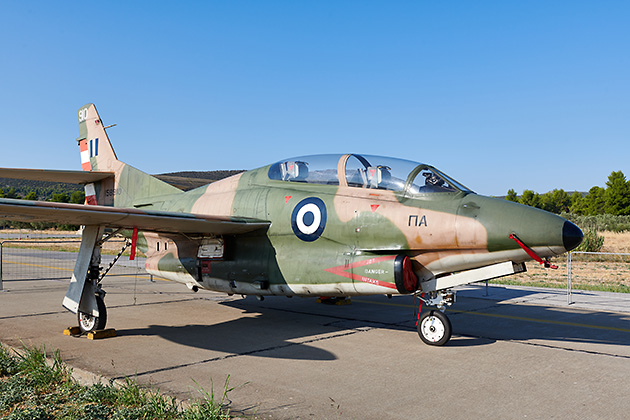
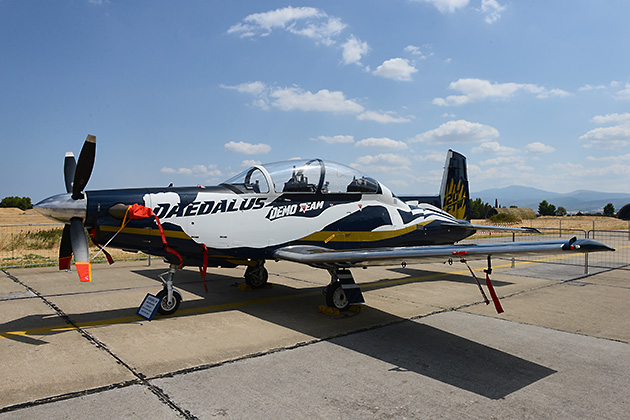
Tanagra Air Base has been the venue for Athens Flying Week since 2016 and the move from Tatoi Air Base presented organizers with the opportunity to include a static display. Statics were split up in to two groups, with rotary wing aircraft being situated to the west of the crowd while fixed wing aircraft were to the east. The helicopters included five examples from the Hellenic Armed Forces. The Army was represented by a Boeing AH-64A APACHE, a Bell OH-58D KIOWA, a Boeing CH-47D CHINOOK and an NHIndustries NH90. On display from the Navy was a Sikorsky S-70B AEGEAN HAWK. The opposite side of the field included a small but high quality showing of fighters and trainers from Greece as well as five international air forces. The Hellenic Air Force contingent included a locally based Mirage 2000-5 from 331 Mira, a Beechcraft T-6A TEXAN II from the demo team ‘Daedalus’ and a lovely camouflaged North American T-2E BUCKEYE. The Luftwaffe brought two Eurofighter EF2000 TYPHOONS and a Panavia TORNADO IDS while the Danish Air Force had their backup demo jet, a Lockheed Martin F-16B FIGHTING FALCON among the statics. The Italian Air Force had a lone Aermacchi M-346 MASTER on display while there were two Pilatus PC-7 trainers from the Austrian Air Force, one of which featured a stunning green and black ‘Snake’ livery.
Tanagra Air Base is also home of the Hellenic Air Force paint shop and this F-4, serial 01507, had one of the freshest paint jobs I had ever seen
S. Clish


Amongst all of these great aircraft were three that stood out as significant highlights for me. The two aircraft from the Royal Saudi Air Force, a Boeing F-15C EAGLE from 2 Squadron and a Tornado IDS from 75 Squadron, were some of their latest aircraft to receive commemorative Saudi National Day markings, celebrating ’90 Years’ and ‘Vision 2030’. Finally, there was a Greek McDonnell Douglas F-4E AUP (Avionics Upgrade Program) PHANTOM II. Every time I see a Phantom I think it will be my last time and the opportunity to see them on the ground and in the air was a major part of the reason I made the trip to Greece. Tanagra Air Base is also home of the Hellenic Air Force paint shop and this F-4, serial 01507, had one of the freshest paint jobs I had ever seen, having just been painted in the past few days, hopefully meaning the type will remain in service for at least another few years.


The Hellenic Armed Forces provided considerable support for AFW, using the first half of each day to showcase some assets from the Air Force, Army and Navy. After opening acts from a glider, a remote controlled model and a paradrop flying the Greek Flag, the show kicked into a high gear that didn’t let up for over four hours. A Canadair CL-415 from 383 Mira flew in from the east and performed a water drop at show centre, between the taxiway and runway. I was surprised that the HAF was able to spare this aircraft for the event as Greece had been severely hit by forest fires throughout August, with many scars visible on the surrounding hillsides during my drive up from Athens.
The aviation component of the Hellenic Army was next and featured an AH-64 Apache, an OH-58 Kiowa and a CH-47 Chinook. Just as these three would work together on the battlefield, the Apache and Kiowa flew support for the Chinook, which was busy lowering troops to the ground. It was quite a treat to watch these three display together as their routine regularly featured crossing aspects that provided a fun, dynamic effect for photography. The rotary action continued with a Hellenic Navy S-70B Aegean Hawk that hovered right in front of the crowd to lower more troops and presented an opportunity to play with very low shutter speeds to capture the elusive rotor blur.
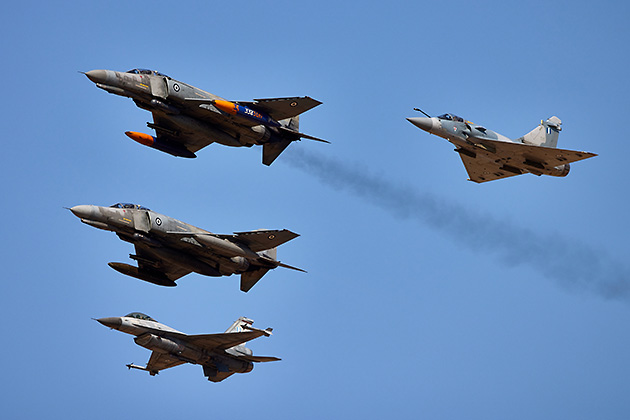

A Tanagra based Mirage was then scrambled to join up with an F-16C from 341 Mira and two F-4E Phantoms from 338 Mira for the opening flyby of the Hellenic Air Force’s ‘Show of Force’ section of the program. The F-16 and Mirage then faced-off in a simulated dogfight that tended to favour the Mirage, as it’s delta wing seemed to allow it to maneuver more easily and remain glued to the tail of the F-16. The Phantoms then returned for an airfield assault and were joined by a Super Puma. Due to the helicopter’s presence the Phantoms unfortunately remained high and didn’t present many photogenic opportunities but it was still such a pleasure to enjoy their participation in the show.
With the departure of the Super Puma to the west it was time for some international performers to display. While the order differed slightly each day, the aircraft were the same. France has always played a major role in Greek Military Aviation since the creation of the Hellenic Aviation Service in 1911. This connection is slated to continue for many years to come, thanks to the 1.92 billion Euro deal that was announced in December 2020 for the purchase of 18 Dassault Rafales that will eventually be based at Tanagra. The Armee de L’air sent the Rafale Solo Display Team to AFW to show the local population the aircraft that will soon be a regular in their sky. The beautifully painted blue display jet was even towed to the edge of the static display each morning so that visitors could get a closer look. During the aerial display, Captain Jerome ‘Schuss’ Thoule thrilled the crowd with a spectacular routine highlighted by plenty of afterburner and even managed to squeeze some vapour out of the dry September air.
The ‘Ribbon’ Phase allows all 8 jets to perform together as a complete team in formations such as the Duck, Arrow and Cross.
Shawn Clish


The Rafale Solo Display Team was joined in AFW by the pride of the French Air Force, the Patrouille de France. It had been 20 years since I last saw their wonderful aerobatic performance and once again I was awed at the job done by the eight pilots in their Dassault-Breguet ALPHAJET E’s. Their show is split up in two sections. The ‘Ribbon’ Phase allows all 8 jets to perform together as a complete team in formations such as the Duck, Arrow and Cross. This is followed by the ‘Synchronization’ Phase which sees smaller groups of 2, 4 or 6 jets conducting more dynamic maneuvers, including multiple crosses by the solo pilots. The Patrouille de France weren’t the only formation aerobatic team to display at AFW, as the Saudi Hawks also took part in the show. The official Aerobatic Team of the Royal Saudi Air Force flies seven BAE Hawk Mk.65A jet trainers painted in an attractive green and white colour scheme. Their routine is also split in two and is enhanced by the white, red, blue and green smoke generators carried by each aircraft. I had never seen the Saudi Hawks perform and thoroughly enjoyed both dimensions of their performance. On Sunday afternoon they closed the show with a formation pass lead by an Aegean Airlines Airbus A320neo.
Tight turns, vertical maneuvering and lots of afterburner made this one of the best jet routines I have ever had the pleasure to witness
Shawn Clish

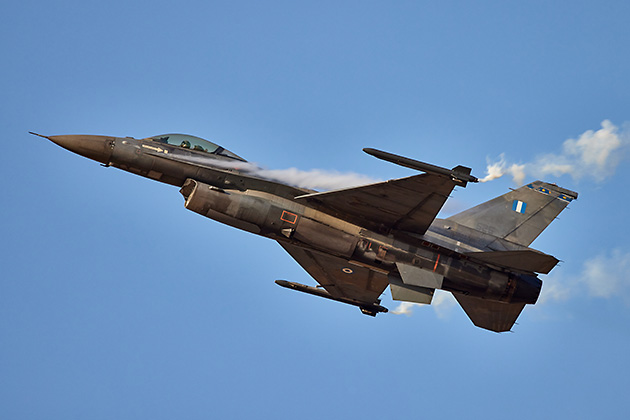
My favourite display of the weekend belonged to the Royal Danish Air Force (RDAF) F-16AM and while it was partly due to its stunning livery, it was also thanks to the aggressive routine performed by the pilot. The flag of Denmark (Dannebrog) is the oldest national flag in the world, first appearing on June 15, 1219 during the Battle of Lindanise. To celebrate the 800th anniversary in 2019, the RDAF painted F-16AM E-191 in full red and white markings, the first time they had fully decorated one of their F-16s since its entry into service in 1980. Still wearing this beautiful paint scheme two years later, The Dannebrog 800 F-16 was one of the contributing factors for my attendance at AFW and I was not disappointed. The jet performed in some spectacular evening light on Saturday and was also fortunate to find some sun and blue sky during Sunday’s more challenging conditions. Tight turns, vertical maneuvering and lots of afterburner made this one of the best jet routines I have ever had the pleasure to witness.
The other F-16 display belonged to the Hellenic Air Force and was performed in a much newer Block 52+ model. Using the callsign ‘Zeus’, the God of the Sky in Ancient Greek Mythology, the team acts as an ambassador for Greece and represents the professionalism and skill of all pilots in the Hellenic Air Force. Unfortunately no longer wearing the sharp blue, white and black colours from a few years prior, the demo jet instead had a very weathered looking Aegean Gray Scheme that made it appear victorious after a bar fight. The twelve minute routine began with a maximum performance takeoff and continued through maneuvers such as a high alpha pass, high speed pass and Falcon turn before a wonderful Dedication Pass to close the display, all emphasized by wing-tip mounted ‘Smokewinders’.
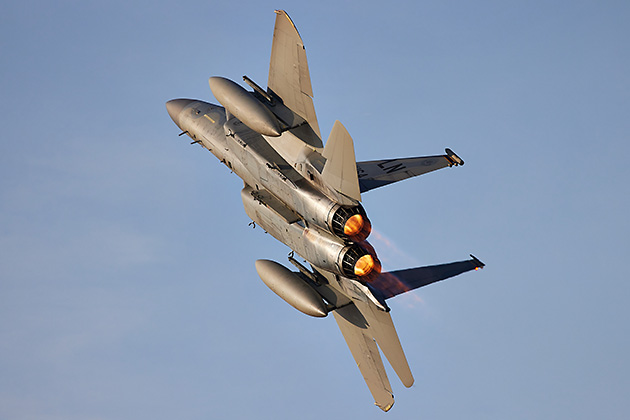

First flown in 1972, the McDonnell Douglas F-15 Eagle still has the most classic appearance of any modern fighter, so it was quite exciting when a pair of US Air Force F-15C’s from Lakenheath AFB were added to the lineup just a few days before the show. Since the US no longer has an officially recognized F-15 Demonstration Team (and hasn’t since 2006) the jets were limited in what they could do. Sometimes simple is better, as the combination of afterburner and low level pitch-up reflected the golden evening light on Saturday and provided some of the best photographic opportunities of the weekend. Perhaps the performance proved a little too stressful for one of the jets though as only one Eagle was able to participate in the show on Sunday.
Possibly the most exceptional aircraft to perform at AFW was the Supermarine Spitfire Mk.IXc MJ755. The ‘Greek Spitfire’ returned to Greece in May after being restored for three years at Biggin Hill in England, flying in Greek airspace for the first time since 1953. The aircraft is a combat veteran from World War II, having flown with the RAF’s Middle East Air Force before being transferred to the Hellenic Air Force in 1947. Warbird pilot Dan Griffith was at the controls during the show and flew beautifully on both days, showing off the capabilities of one of the top aircraft of the era. Following the show, Dan began the process of training two pilots from the HAF to fly the aircraft so that it may be flown by Greek pilots at events in the future.
Verdict: My decision to attend Athens Flying Week proved to be hugely rewarding. Tanagra Air Base provided plenty of great opportunities thanks to the layout of the event and enhanced by the favourable weather conditions. Strong support from the Hellenic Armed Forces, both on the ground and in the air, was strengthened thanks to the participation by multiple international air forces. I thoroughly enjoyed every aspect of my trip and highly recommend attending next year when the show is scheduled for September 17 and 18.
Shawn Clish / CHK6

